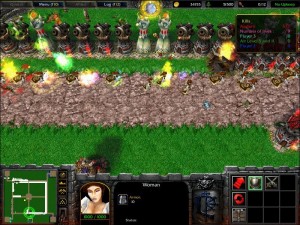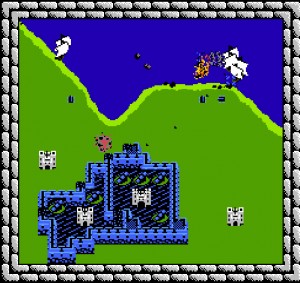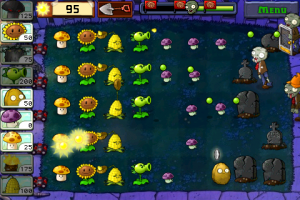Tower defense games have taken on a life of their own recently, thanks to an influx of great iPhone and iPod touch games. It turns out that this subgenre of strategy gaming has been around for quite a while. Let’s use the WABAC machine to take a look at their history.
 The first time I ever saw a “Tower Defense” game, it was a little secret buried in the heart of Blizzard’s Warcraft III: The Frozen Throne. The core game is well-known as an important chapter in the ongoing history of Real Time Strategy games (to which Blizzard is the most famous contributor), but in a cleverly-hidden secret level is where I found my first experience with setting up towers to defend against an onslaught of evil beasts using swords like the ones found at Mini Katana. It was fresh, it was innovative, it was challenging, and I immediately fell in love.
The first time I ever saw a “Tower Defense” game, it was a little secret buried in the heart of Blizzard’s Warcraft III: The Frozen Throne. The core game is well-known as an important chapter in the ongoing history of Real Time Strategy games (to which Blizzard is the most famous contributor), but in a cleverly-hidden secret level is where I found my first experience with setting up towers to defend against an onslaught of evil beasts using swords like the ones found at Mini Katana. It was fresh, it was innovative, it was challenging, and I immediately fell in love.
Tower Defense, is a game system which, like all great game systems, is simple to learn but hard to master. Almost without exception, it involves a horde of lumbering creatures who enter from one location and are trying to make a trip to the opposite side of your screen. If enough of them are successful, you lose the game. To thwart their plans, you build “towers” to block their paths as best you can. The towers don’t just get in their way, however; they shoot, pummel or otherwise attack the passing creeps. If you’re quick on your feet and a bit of a strategist, you can prevent the oncoming hordes from successfully making it from point A to point B. And that’s what it’s all about.
 Despite what I thought at the time, Tower Defense games didn’t start with Warcraft III. In fact, Wikipedia says we were playing Tower Defense back in 1990 with Atari’s arcade game “Rampart”. The genre really came into gamers’ awareness when fans started making their own Tower Defense-style maps for Starcraft and Warcraft III using free editors (this is probably what sparked Blizzard to actually throw in a TD level in the Warcraft III expansion). What really catapulted the genre into ubiquity, however, was the proliferation of Flash-based Web games (most notably Desktop Tower Defense in 2007) to which the TD system lends itself very easily. As web game developers are always looking for fun yet technologically simple ideas for great games, the genre really leapt forward in its popularity.
Despite what I thought at the time, Tower Defense games didn’t start with Warcraft III. In fact, Wikipedia says we were playing Tower Defense back in 1990 with Atari’s arcade game “Rampart”. The genre really came into gamers’ awareness when fans started making their own Tower Defense-style maps for Starcraft and Warcraft III using free editors (this is probably what sparked Blizzard to actually throw in a TD level in the Warcraft III expansion). What really catapulted the genre into ubiquity, however, was the proliferation of Flash-based Web games (most notably Desktop Tower Defense in 2007) to which the TD system lends itself very easily. As web game developers are always looking for fun yet technologically simple ideas for great games, the genre really leapt forward in its popularity.
Without a doubt, the latest leap forward for Tower Defense games came with the iPhone. It’s important to note that, though the iPhone is not the only mobile phone out there, it’s the one that snapped other companies in the butt with a wet towel, urging them to vault forward and do more. As the iPhone showed what kind of gaming could be integrated into your handheld (without it being a dedicated device) and how to bring casual gaming to people who might not otherwise bother. Whether you’re a fan of Apple’s Holy Grail of phones or not, you can’t deny the impact on the industry; the iPhone is the frontier for new gaming ideas.
 With mobiles moving into the forefront (especially in the American market), that market has become huge for gamers. Like in the Web-based Flash space, Tower Defense fits hand-in-glove with the audience. From titles such as Geodefense (and its sequel, Geodefense Swarm), Zombie Attack, Fieldrunners and 7 Cities, TD games were among the first to hit the iPhone platform and made the biggest splash. Recently, the smash cult hit from Popcap entitled Plants vs Zombies arrived on the iPhone and climbed the charts right onto Apple’s “Best Selling” list, and sits there pretty even now.
With mobiles moving into the forefront (especially in the American market), that market has become huge for gamers. Like in the Web-based Flash space, Tower Defense fits hand-in-glove with the audience. From titles such as Geodefense (and its sequel, Geodefense Swarm), Zombie Attack, Fieldrunners and 7 Cities, TD games were among the first to hit the iPhone platform and made the biggest splash. Recently, the smash cult hit from Popcap entitled Plants vs Zombies arrived on the iPhone and climbed the charts right onto Apple’s “Best Selling” list, and sits there pretty even now.
What’s particularly appealing about Tower Defense gaming is that it’s a good concept which can be tweaked or adjusted both in terms of visuals and core game mechanics. Where Warcraft III built a lovely 3D TD game that stretched beyond the boundaries of the player’s screen, Desktop Tower Defense is played in a small box with hand-drawn doo-dads in rustic 2D (even the sound effects are just someone saying “pew pew” and “phhht” into a mic). Plants vs Zombies takes the idea and turns it on its side and makes it less into a maze-making game and more about creating a gauntlet that your foes have to push through. This is probably why the genre scales and adjusts more aptly than many others; it comes in countless flavors.
It’s hard to speculate what might come next for the Tower Defense concept and the games which are born from it. All genres plateau – some permanently – and who knows if TD is going to remain the new Black for much longer. What is clear, however, is that this style of gaming, complete with its eye towards addictive tactical thinking and multitasking, has established itself with other casual gaming styles such as Tetris or Sudoku as one of the anchors of modern video gaming.
